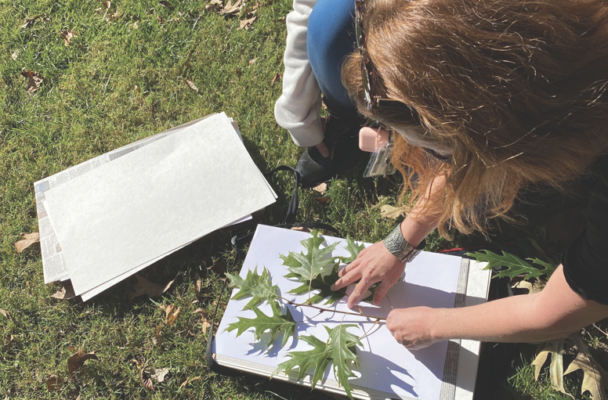Professor and students analyze color-changing leaves

Dr. Nicole Hughes and sophomore Trinity Erjo prepare to press a branch of leaves for their research. Photo by Corinne Gumpman
By Corinne Gumpman
Staff Writer
Around the world, individuals are studying the evolution of autumn colors. The amount of research is limited, but Dr. Nicole M. Hughes, associate professor of biology at High Point University, is one of the scientists working to answer why leaves turn red during autumn. She is collaborating with foreign researchers, including Dr. Howard Thomas of the Aberystwyth University Institute of Biological, Environmental and Rural Sciences in England and Dr. Snorre B. Hagen of the Norwegian Institute of Bioeconomy Research. She is also working with a handful of HPU students to gather data and make observations.
Leaves are commonly green because of chlorophyll’s high concentration in the leaves, but leaves change colors to be orange, yellow, red or brown during select seasons of the year. The pigments that are responsible for this visible color change are carotenoids and anthocyanins. Carotenoids are any class of mainly yellow, orange or red fat-soluble pigments that give color to select plants such as tomatoes and autumn leaves. Anthocyanins are also pigments responsible for the red color seen in leaves. Brown leaves are simply dead cells. It is a common understanding that leaves change colors, but not everyone thinks about why.
Currently, two hypotheses attempt to explain the reddening of leaves in autumn. The first is the photoprotection theory. It states that red pigments called anthocyanins protect against light’s harmful effects at low temperatures. This explanation considers the cooler weather of autumn months, when the risk of damage to leaves is exceptionally high because of cold temperatures.
The other potential explanation is that anthocyanins exist to protect plants from insects. According to this theory, the coloration of leaves signals that the tree is not a suitable host for insects due to its current condition. The tree would benefit from fewer insects migrating to it because insects cause considerable damage to the species.
Emily Gonzalez is an HPU junior working on one of Hughes’ research projects. Gonzalez has been categorizing the phenotypes of the cranefly orchid, a flower native to the southeastern U.S. that reddens to the point of being purple because of anthocyanin pigments. She is studying the reasoning behind color changes in the plant genus, Tipularia. By observing its ancestry and the Tipularia genus, as well as finding cranefly orchids in the wild or on the ecological resource sharing site “Inaturalist,” Emily works to determine the plants’ phenotypes and morphologies.
“I never actually liked evolution and plant research,” Gonzalez said. “However, after working with Hughes, I actually love it. All students should step out of their comfort zones because they could discover something they are passionate about.”
Hughes’ research is not limited to the cranefly orchid. She has gathered more HPU students, including senior Blaine Fitzgerald, to identify and examine different species of trees on and off campus. The students perform nature surveys to collect information about other species. They make cross sections out of the individual leaves to determine what layer of the leaf contains the red pigment. These observations can only be made using a microscope. Advised by Hughes, they collect information about the varying species that may affect pigments’ concentrations in specific trees.
Hughes and her team are working diligently to gather their data samples to investigate the topic further. For more information on her research, Hughes can be contacted at nhughes@highpoint.edu.